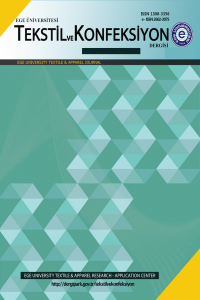Comfort Properties of Functional Double Bed Knitted Fabric for Firefighters Underwear
Comfort Properties of Functional Double Bed Knitted Fabric for Firefighters Underwear
double bed knitted fabrics, air permeability, thermal conductivity vapour water permeability, wetting, flame-retardant,
___
- [1] Angelova, R.A. 2016. Textiles and human thermophysiological comfort in the indoor environment. Boca Raton: Taylor & Francis.
- [2] Morel, A., Bedek, G., Salaün, F., Dupont, D. A review of heat transfer phenomena and the impact of moisture on firefighters' clothing and protection. Ergonomics 57(7), 1078–1089.
- [3] Petrusıc, S., Onofreı, E., Bedek, G., Codau, C., Dupont, D., Soulat, D. Moisture management of underwear fabrics and linings of firefighter protective clothing assemblies. The journal of the Textile institute 106(12), 1270–1281.
- [4] Özdil, N., Marmarali, A. and Kretzschmar S.D. Effect of yarn properties on thermal comfort of knitted fabrics. International journal of thermal sciences 46, 1318–1322. DOI: 10.1016/j.ijthermalsci.2006.12.002.
- [5] Yang, Y., Yu, X., Chen. L. and Zhang, P. Effect of knitting structure and yarn composition on thermal comfort properties of bi-layer knitted fabrics. Textile research journal 91(1–2), 3–17. DOI: 10.1177/0040517520932557.
- [6] Oğlakcioğlu, N. Marmarali, A. Thermal comfort properties of some knitted structures. Fibres & textiles in Eastern Europe 15(5-6), 64 – 65.
- [7] Au, K.F. (ed.). 2011. Advances in knitting technology. Cambridge: Woodhead Publishing. [8] Brzin, B. 2020. Development of functional knitted fabrics for firefighters` underwear (Master thesis). Retrieved from: https://repozitorij.uni-lj.si/IzpisGradiva.php?id=123336&lang=slv
- [9] Knific, K. 2021. Useful properties of right-right knitted fabrics (Diploma thesis). Retrieved from: https://repozitorij.uni-lj.si/IzpisGradiva.php?id=125435&lang=slv
- [10] Houshyar, S., Padhye, R., Troynikov, O., Nayak, R. and Ranjan, S. Evaluation and improvement of thermophysiological comfort properties of firefighters’ protective clothing containing super absorbent materials. 2015. The journal of the Textile institute 106(12), 1394–1402. DOI: 10.1080/00405000.2014.995930.
- [11] Wang, Y., Zhang, Z., Li, J. and Zhu, G. 2013. Effects of inner and outer clothing combinations on firefighter ensembles’ thermal- and moisture-related comfort levels. The journal of the Textile institute 104(5), 530-540. DOI: 10.1080/00405000.2012.750030
- [12] Atalay, O., Bahadir, S.K.and Kalaoglu, F. An Analysis on the Moisture and Thermal Protective Performance of Firefighter Clothing Based on Different Layer Combinations and Effect of Washing on Heat Protection and Vapour Transfer Performance. 2015. Advances in Materials Science and Engineering, Article ID 540394, 8 p. 1DOI: 0.1155/2015/540394.
- [13] Onofrei, E., Dupont, D., Petrusic, S., Soulat, D., Dedek, G. and Codau, T.C. Modeling of heat transfer through multilayer firefighter protective clothing. 2014. Industria textila 65(5), 277-282.
- [14] Ajmeri, J.R. and Bhattacharya, S.S. Comparative analysis of the thermal comfort properties of knitted fabrics made of cotton and modal fibres. International journal of textile and fashion technology 3(1), 1-10.
- [15] Pavko Čuden, A. and Stanković Elesini, U. Elastane Addition Impact on Structural and Transfer Properties of Viscose and Polyacrylonitrile Knits. Acta Chimica Slovenica 57(4), 957–962.
- ISSN: 1300-3356
- Yayın Aralığı: Yılda 4 Sayı
- Başlangıç: 1991
- Yayıncı: Ege Üniversitesi
Analyzing Efficiency and Productivity Changes of Turkish Textile Firms
Başak APAYDIN AVŞAR, Önder BELGİN
Nazife KORKMAZ MEMİŞ, Sibel KAPLAN
Investigation on Thermal Comfort Characteristics of Newly Engineered Yarn Umorfil® Knitted Fabrics
Poisson’s Ratio of Non-Woven Spun Bonded Fabric for Medical Apparel
Dr.pasupathy RAMAMURTHY, Suganthi PARANTHAMAN
Comfort Properties of Functional Double Bed Knitted Fabric for Firefighters Underwear
živa ZUPİN, Karmen KNİFİC, Alenka PAVKO ČUDEN
Imidazolium and Ammonium-Based Ionic Liquids for Reactive Dyeing
Havva Nur ÖZDEMİR, Gülşah Ekin KARTAL, Özgür Yasin KESKİN, Yasemin SEKİ
Ece KALKANLI TURAN, Belkıs ZERVENT ÜNAL
Copper-Electroplating of Biodegradable PCL Nanofiber Mats
Serkan TEZEL, Sebnem DUZYER GEBİZLİ, Ahd JADOUH, Serpil KORAL KOÇ, Ahmet PEKSÖZ
